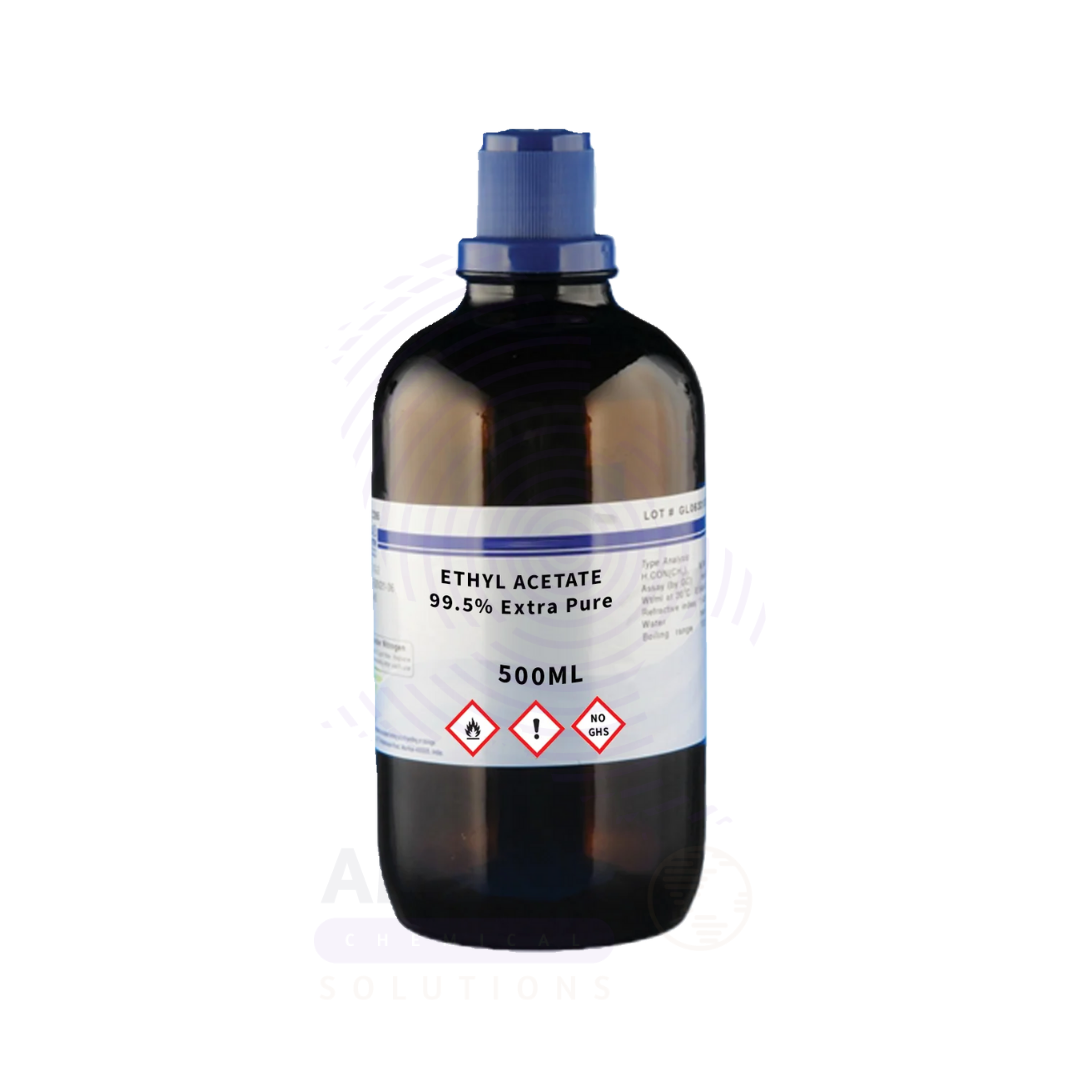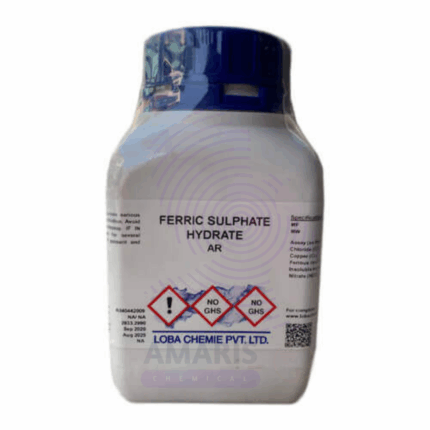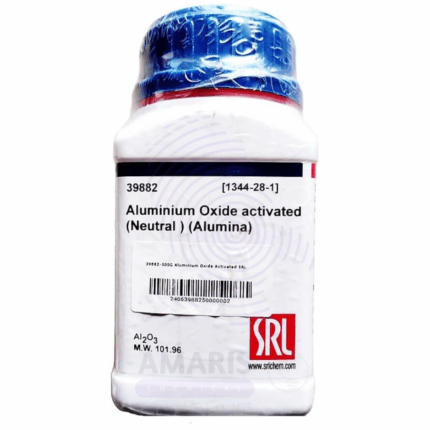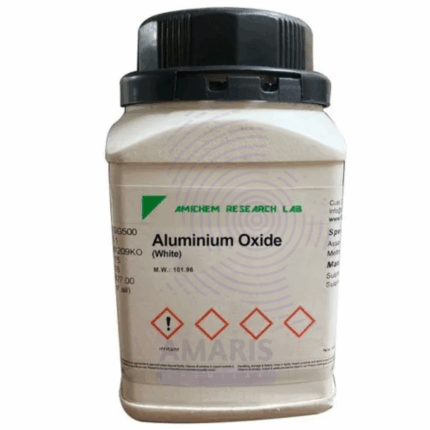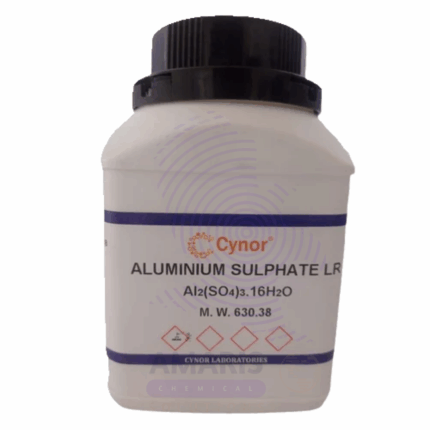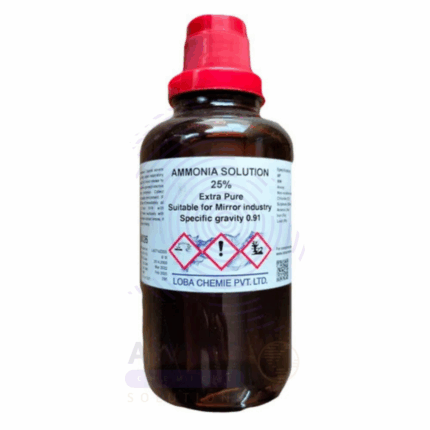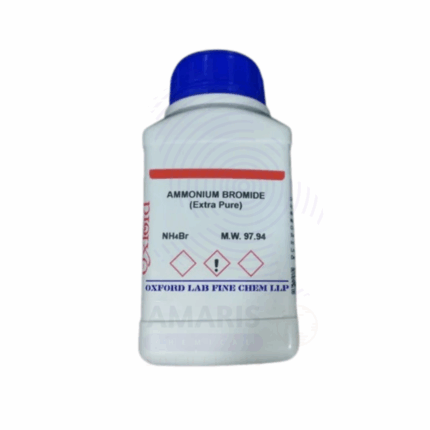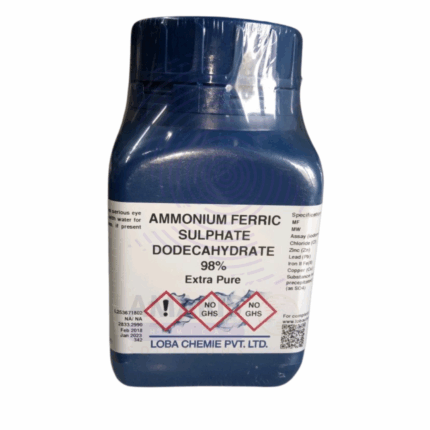“Ammonium Cupric Chloride Extra Pure” has been added to your cart. View cart

Ylang Ylang Oil
$ 58.70 Original price was: $ 58.70.$ 58.59Current price is: $ 58.59.

Strawberry Liquid Flavour Food Grade
$ 33.00 Original price was: $ 33.00.$ 32.81Current price is: $ 32.81.
Ethyl Acetate Extra Pure
$ 33.90 Original price was: $ 33.90.$ 33.00Current price is: $ 33.00.
Whatsapp Order
Ethyl Acetate Extra Pure is a high-purity solvent widely used in analytical laboratories, chromatography, and sample preparation due to its fast evaporation and low toxicity. In laboratory settings, it’s valued for extraction, purification, and reaction medium roles, especially in organic synthesis. Its low water content and consistent purity make it suitable for GC/HPLC applications, adhesive formulations, and residue analysis. It must be handled in well-ventilated areas, away from heat or flame, and stored in tightly sealed containers to maintain its stability and prevent contamination.
Description
Table of Contents
Toggle
Ethyl Acetate Extra Pure
Primary Uses
- Solvent in chromatography (TLC, HPLC, GC):
Commonly used as a mobile phase or solvent for sample preparation due to its volatility and medium polarity. - Solvent for extraction and purification:
Ideal for liquid-liquid extraction of organic compounds and for recrystallization procedures. - Solvent in organic synthesis:
Used to dissolve reactants or as a reaction medium in chemical transformations. - Solvent for paints, coatings, and adhesives testing:
Evaluated for its performance in solubility and formulation studies.
Secondary Uses
- Drying agent in sample preparation:
Assists in the removal of moisture from samples prior to analysis. - Cleaning and degreasing agent:
Useful in cleaning lab glassware and equipment without leaving residues. - Intermediate in esterification and transesterification studies:
Sometimes used as both reactant and solvent in academic or industrial synthesis. - Evaporation studies and volatility reference:
Used to study evaporation rates in analytical or environmental testing.
Additional information
| PACK SIZE |
2.5 Litres Glass bottle |
|---|
KEY PRODUCT FEATURES
1. Basic Identification Attributes
- Chemical Name: Ethyl Acetate
- Synonyms: Ethyl ethanoate, Acetic ether, EA
- Chemical Formula: C₄H₈O₂
- CAS Number: 141-78-6
- Grade: Extra Pure (Laboratory Grade, 99.5%)
- Appearance: Clear, colorless liquid
- Odor: Fruity, sweet, characteristic ester-like
2. Physical & Chemical Properties
- Molecular Weight: 88.11 g/mol
- Purity: 99.5%
- Boiling Point: 77.1 °C
- Melting Point: –83.6 °C
- Flash Point: –4 °C (closed cup)
- Density: 0.902 g/cm³ at 20 °C
- Solubility: Slightly soluble in water, miscible with most organic solvents
3. Safety & Hazard Attributes
- GHS Classification:
- Flammable Liquid (Category 2)
- Eye Irritation (Category 2A)
- Specific Target Organ Toxicity - Single Exposure (Category 3)
- Hazard Statements:
- H225: Highly flammable liquid and vapor
- H319: Causes serious eye irritation
- H336: May cause drowsiness or dizziness
- PPE Requirements:
- Chemical splash goggles
- Nitrile gloves
- Lab coat
- Use in fume hood
- First Aid Measures:
- Inhalation: Move to fresh air, monitor breathing
- Skin Contact: Wash with soap and water
- Eye Contact: Rinse thoroughly with water
- Ingestion: Rinse mouth, do not induce vomiting, seek medical help
4. Storage & Handling Attributes
- Storage Conditions:
- Store in a tightly sealed container
- Keep in a cool, well-ventilated flammable storage cabinet
- Away from heat, sparks, and open flames
- Handling Notes:
- Ground all equipment during transfer
- Avoid prolonged inhalation of vapors
5. Regulatory & Compliance Attributes
- EC Number: 205-500-4
- UN Number: UN 1173
- Hazard Class: 3 (Flammable Liquid)
- Packing Group: II
- REACH Status: Registered
6. Laboratory Applications
- Primary Uses:
- Solvent in chromatography, TLC, and extraction
- Sample preparation in spectroscopy
- Component in organic synthesis
- Paints, coatings, and adhesives testing
- Secondary Uses:
- Degreasing agent
- Cleaning solvent for lab glassware
- Perfume and flavor formulation testing
SAFETY HANDLING PRECAUTIONS
SAFETY PRECAUTIONS
- Highly flammable liquid and vapor
- Use with adequate ventilation, away from sparks, flames, or heat
- PPE: Gloves, safety goggles, lab coat
- Storage:
- Store in a tightly closed container
- Keep in a cool, dry, well-ventilated area away from oxidizers
FIRST AID MEASURES
- Inhalation: Move to fresh air, seek medical help if symptoms persist
- Skin Contact: Wash with soap and water
- Eye Contact: Rinse with water for at least 15 minutes
- Ingestion: Rinse mouth, do not induce vomiting—seek immediate medical attention
Related products
Aluminium Ferric Sulphate Extra Pure
Aluminium Ferric Sulphate Extra Pure is a high-purity, yellowish to light brown crystalline solid composed of aluminum, iron, and sulfate ions, commonly used in laboratory settings for analytical, coordination, and inorganic chemistry research. Its dual-metal composition makes it valuable for studying metal ion interactions, flocculation processes, and as a reagent in qualitative analysis of phosphates and tannins. The compound also finds application in preparing standard solutions and in experiments related to coagulation and sedimentation. Its extra pure grade ensures consistent performance with minimal contamination, making it ideal for precise, controlled experimentation. It should be stored in tightly sealed containers in a dry, cool environment to maintain stability and prevent moisture uptake.
Aluminium Oxide Active Neutral Extra Pure
Aluminium Oxide Active Neutral Extra Pure is a high-purity, fine white powder known for its high surface area and neutral pH, making it ideal for chromatography, adsorption, and catalyst support in laboratory research. Its active form ensures excellent capacity for separating and purifying organic compounds without altering their chemical structure, especially in column chromatography applications. Commonly used in analytical, organic synthesis, and material science laboratories, it provides consistent performance in adsorption studies, drying of solvents, and reaction monitoring. The extra pure grade ensures extremely low levels of impurities, suitable for high-precision experimental work. To maintain its activity, it should be stored in airtight containers away from moisture and reactive chemicals.
Aluminium Oxide Extra Pure
Aluminium Oxide Extra Pure is a high-purity, white, odorless crystalline powder widely used in laboratory applications for its chemical stability, hardness, and high melting point. It serves as a reliable reagent in inorganic synthesis, a polishing and grinding medium in sample preparation, and a support material for catalysts in chemical reactions. This form of alumina is also used in adsorption studies, ceramic research, and as a desiccant in controlled drying processes. Its extra pure grade ensures minimal contamination, making it suitable for sensitive analytical work and high-precision experiments. For optimal performance, it should be stored in a dry, tightly sealed container to prevent moisture absorption and maintain its physical integrity.
Aluminium Sulphate Anhydrous Extra Pure
Aluminium Sulphate Anhydrous Extra Pure is a high-purity, white crystalline or powdery solid commonly used in laboratory chemistry as a source of aluminum ions for precipitation, titration, and coordination studies. Its anhydrous form provides a concentrated and stable option for applications requiring precise control over water content, such as analytical reagent preparation, pH adjustment, and synthesis of other aluminum salts. This compound is also used in paper sizing experiments, dye fixation, and water treatment research. The extra pure grade ensures very low levels of contaminants, supporting accurate and reproducible results in sensitive experimental work. It should be stored in airtight containers in a dry area to prevent moisture absorption and preserve its chemical integrity.
Ammonia Solution Extra Pure
Ammonia Solution Extra Pure is a high-purity, clear, colorless liquid composed of ammonia gas dissolved in water, emitting a strong, characteristic pungent odor. Widely used in laboratory chemistry, it serves as a crucial reagent in acid-base titrations, complexometric analysis, and the preparation of ammonium salts and metal-ammonia complexes. Its alkaline nature makes it valuable for pH adjustment, cleaning of laboratory glassware, and as a reducing agent in certain analytical procedures. The extra pure grade ensures low levels of impurities, supporting reliable results in sensitive experimental work. Due to its volatility and corrosiveness, it should be handled in well-ventilated areas and stored in tightly sealed, chemically resistant containers.
Ammonium Bromide Extra Pure
Ammonium Bromide Extra Pure is a high-purity, white crystalline powder highly soluble in water, widely used in laboratory settings for analytical, photographic, and synthetic applications. It serves as a reliable source of bromide ions in chemical reactions and is commonly used in preparing photographic emulsions, corrosion inhibitors, and certain pharmaceuticals. In analytical chemistry, it is employed in qualitative and quantitative analysis involving halide ion detection. The extra pure grade ensures minimal contamination, making it ideal for sensitive research and high-precision work. To preserve its stability and prevent moisture uptake, it should be stored in well-sealed containers in a cool, dry environment.
Ammonium Ferric Sulphate Extra Pure
Ammonium Ferric Sulphate Extra Pure, also known as ferric ammonium sulfate or iron alum, is a high-purity, violet to light purple crystalline compound used extensively in laboratory settings for analytical and inorganic chemistry. It serves as a reliable oxidizing agent and a standard in redox titrations, particularly in permanganometry. Its stable and non-hygroscopic nature makes it ideal for preparing standard iron solutions, studying coordination complexes, and teaching laboratory procedures involving iron(III) salts. The extra pure grade ensures minimal interference from impurities, enabling accurate and reproducible results in sensitive experiments. It should be stored in a dry, cool environment in well-sealed containers to preserve its chemical integrity.


 Preservatives(food)
Preservatives(food) Flavor Enhancers
Flavor Enhancers Acidulants
Acidulants Sweeteners
Sweeteners Antioxidants
Antioxidants Colorants(food)
Colorants(food) Nutraceutical Ingredients (food)
Nutraceutical Ingredients (food) Nutrient Supplements
Nutrient Supplements Emulsifiers
Emulsifiers
 Collectors
Collectors Dust Suppressants
Dust Suppressants Explosives and Blasting Agents
Explosives and Blasting Agents Flocculants and Coagulants
Flocculants and Coagulants Frothers
Frothers Leaching Agents
Leaching Agents pH Modifiers
pH Modifiers Precious Metal Extraction Agents
Precious Metal Extraction Agents
 Antioxidants(plastic)
Antioxidants(plastic) Colorants (Pigments, Dyes)
Colorants (Pigments, Dyes) Fillers and Reinforcements
Fillers and Reinforcements Flame Retardants
Flame Retardants Monomers
Monomers Plasticizers
Plasticizers Polymerization Initiators
Polymerization Initiators Stabilizers (UV, Heat)
Stabilizers (UV, Heat)
 Antifoaming Agents
Antifoaming Agents Chelating Agents
Chelating Agents Coagulants and Flocculants
Coagulants and Flocculants Corrosion Inhibitors
Corrosion Inhibitors Disinfectants and Biocides
Disinfectants and Biocides Oxidizing Agents
Oxidizing Agents pH Adjusters
pH Adjusters Scale Inhibitors( water)
Scale Inhibitors( water)
 Antioxidants(cosmetic)
Antioxidants(cosmetic) Emollients
Emollients Fragrances and Essential Oils
Fragrances and Essential Oils Humectants
Humectants Preservatives
Preservatives Surfactants(cosmetic)
Surfactants(cosmetic) Thickeners
Thickeners UV Filters
UV Filters
 Fertilizers
Fertilizers Soil Conditioners
Soil Conditioners Plant Growth Regulators
Plant Growth Regulators Animal Feed Additives
Animal Feed Additives Biostimulants
Biostimulants Pesticides (Herbicides, Insecticides, Fungicides)
Pesticides (Herbicides, Insecticides, Fungicides)
 Active Pharmaceutical Ingredients (APIs)
Active Pharmaceutical Ingredients (APIs) Excipients
Excipients Solvents(pharmaceutical)
Solvents(pharmaceutical) Antibiotics
Antibiotics Antiseptics and Disinfectants
Antiseptics and Disinfectants Vaccine Adjuvants
Vaccine Adjuvants Nutraceutical Ingredients (pharmaceutical)
Nutraceutical Ingredients (pharmaceutical) Analgesics & Antipyretics
Analgesics & Antipyretics
 Analytical Reagents
Analytical Reagents Solvents(lab)
Solvents(lab) Chromatography Chemicals
Chromatography Chemicals Spectroscopy Reagents
Spectroscopy Reagents microbiology-and-cell-culture-reagents
microbiology-and-cell-culture-reagents Molecular Biology Reagents
Molecular Biology Reagents Biochemical Reagents
Biochemical Reagents Inorganic and Organic Standards
Inorganic and Organic Standards Laboratory Safety Chemicals
Laboratory Safety Chemicals Specialty Laboratory Chemicals(Special Laboratory Equipment)
Specialty Laboratory Chemicals(Special Laboratory Equipment)
 Demulsifiers
Demulsifiers Hydraulic Fracturing Fluids
Hydraulic Fracturing Fluids Scale Inhibitors(oil)
Scale Inhibitors(oil) Surfactants(oil)
Surfactants(oil) Drilling Fluids
Drilling Fluids
 Dyes and Pigments
Dyes and Pigments Bleaching Agents
Bleaching Agents Softening Agents
Softening Agents Finishing Agents
Finishing Agents Antistatic Agents
Antistatic Agents
 Admixtures
Admixtures Waterproofing Agents
Waterproofing Agents Sealants and Adhesives
Sealants and Adhesives Curing Compounds
Curing Compounds Concrete Repair Chemicals
Concrete Repair Chemicals Anti-Corrosion Coatings
Anti-Corrosion Coatings
 Surfactants(cleaning)
Surfactants(cleaning) Builders
Builders Enzymes
Enzymes Solvents (Cleaning)
Solvents (Cleaning) Fragrances
Fragrances
 Electronic Chemicals
Electronic Chemicals Catalysts
Catalysts Lubricants
Lubricants Photographic Chemicals
Photographic Chemicals Refrigerants
Refrigerants Automotive chemicals
Automotive chemicals Pyrotechnic Chemicals
Pyrotechnic Chemicals
 Biodegradable Surfactants
Biodegradable Surfactants Bio-based Solvents
Bio-based Solvents Renewable Polymers
Renewable Polymers Carbon Capture Chemicals
Carbon Capture Chemicals Wastewater Treatment Chemicals
Wastewater Treatment Chemicals
 Pigments
Pigments Solvents(paint)
Solvents(paint) Specialty Coatings
Specialty Coatings Binders/Resins
Binders/Resins Additives
Additives Driers
Driers Anti-Corrosion Agents
Anti-Corrosion Agents Functional Coatings
Functional Coatings Application-Specific Coatings
Application-Specific Coatings
 Fresh Herbs
Fresh Herbs Ground Spices
Ground Spices Whole Spices
Whole Spices Spice Blends
Spice Blends Dried Herbs
Dried Herbs
 Leavening Agents
Leavening Agents Dough Conditioners
Dough Conditioners Flour Treatments
Flour Treatments Fat Replacers
Fat Replacers Decoratives
Decoratives Preservatives(baking)
Preservatives(baking)
 Plasticizers & Softeners
Plasticizers & Softeners Reinforcing Agents
Reinforcing Agents Adhesion Promoters
Adhesion Promoters Vulcanizing Agents
Vulcanizing Agents Antidegradants
Antidegradants Blowing Agents
Blowing Agents Fillers & Extenders
Fillers & Extenders Accelerators & Retarders
Accelerators & Retarders